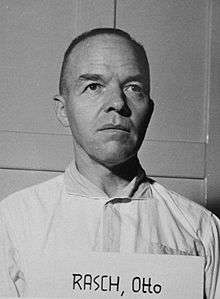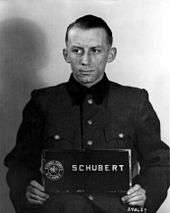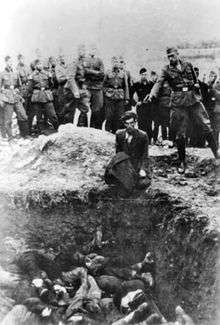Einsatzgruppen trial
| The Einsatzgruppen trial | |
|---|---|
|
| |
|
Ohlendorf testifying on his own behalf | |
|
Paul Blobel is sentenced to death |
The Einsatzgruppen trial (officially, The United States of America vs. Otto Ohlendorf, et al.) was the ninth of the twelve trials for war crimes the US authorities held in their occupation zone in Germany in Nuremberg after the end of World War II. These twelve trials were all held before US military courts, not before the International Military Tribunal. They took place in the same rooms at the Palace of Justice. The twelve US trials are collectively known as the "Subsequent Nuremberg Trials" or, more formally, as the "Trials of War Criminals before the Nuremberg Military Tribunals" (NMT).
The case
The Einsatzgruppen were Schutzstaffel (SS) mobile death squads, operating behind the front line in Nazi-occupied eastern Europe. From 1941 to 1943 alone, they murdered more than one million Jews and tens of thousands of "partisans", Romani, disabled persons, political commissars, Slavs, and others. The 24 defendants in this trial were all officers of these Einsatzgruppen and faced mass murder charges. The tribunal stated in its judgment:
... in this case the defendants are not simply accused of planning or directing wholesale killings through channels. They are not charged with sitting in an office hundreds and thousands of miles away from the slaughter. It is asserted with particularity that these men were in the field actively superintending, controlling, directing, and taking an active part in the bloody harvest.[1]
The judges in this case, heard before Military Tribunal II-A, were Michael A. Musmanno (presiding judge and Naval officer) from Pennsylvania, John J. Speight from Alabama, and Richard D. Dixon from North Carolina. The Chief of Counsel for the Prosecution was Telford Taylor; the Chief Prosecutor for this case was Benjamin B. Ferencz. The indictment was filed initially on July 3 and then amended on July 29, 1947 to also include the defendants Steimle, Braune, Hänsch. Strauch, Klingelhöfer, and von Radetzky. The trial lasted from September 29, 1947 until April 10, 1948.
Indictment
- Crimes against humanity through persecutions on political, racial, and religious grounds, murder, extermination, imprisonment, and other inhumane acts committed against civilian populations, including German nationals and nationals of other countries, as part of an organized scheme of genocide.
- War crimes for the same reasons, and for wanton destruction and devastation not justified by military necessity.
- Membership of criminal organizations, the SS, the Sicherheitsdienst (SD), or the Gestapo, which had been declared criminal organizations previously in the international Nuremberg Military Tribunals.
All defendants were charged on all counts. All defendants pleaded "not guilty". The tribunal found all of them guilty on all counts, except Rühl and Graf, who were found guilty only on count 3.
Defendants
| Name | Photo | Function | Sentence | Outcome, 1951 Amnesty |
|---|---|---|---|---|
| Otto Ohlendorf | SS Gruppenführer; member of the SD; commanding officer of Einsatzgruppe D | Death by hanging | executed June 7, 1951[2] | |
| Heinz Jost |  |
SS Brigadeführer; member of the SD; commanding officer of Einsatzgruppe A | Lifetime imprisonment | commuted to 10 years; died 1964 |
| Erich Naumann | SS Brigadeführer; member of the SD; commanding officer of Einsatzgruppe B | Death by hanging | executed June 7, 1951[2] | |
| Otto Rasch |  |
SS Brigadeführer; member of the SD and the Gestapo; commanding officer of Einsatzgruppe C | Removed from the trial on February 5, 1948 due to medical reasons | died 1 November 1948 |
| Erwin Schulz | SS Brigadeführer; member of the Gestapo; commanding officer of Einsatzkommando 5 of Einsatzgruppe C | 20 years | commuted to 15 years; released 9 January 1954-died 1981 | |
| Franz Six |  |
SS Brigadeführer; member of the SD; commanding officer of Vorkommando Moscow of Einsatzgruppe B | 20 years | commuted to 15 years; released 30 September 1952-died 1975 |
| Paul Blobel |  |
SS Standartenführer; member of the SD; commanding officer of Sonderkommando 4a of Einsatzgruppe C | Death by hanging | executed June 7, 1951[2] |
| Walter Blume | SS Standartenführer; member of the SD and the Gestapo; commanding officer of Sonderkommando 7a of Einsatzgruppe B | Death by hanging | commuted to 25 years; released 1955, died 1974 | |
| Martin Sandberger |  |
SS Standartenführer; member of the SD; commanding officer of Sonderkommando 1a of Einsatzgruppe A | Death by hanging | commuted to lifetime imprisonment, released in 1958, died 2010 |
| Willi Seibert | SS Standartenführer; member of the SD; Deputy Chief of Einsatzgruppe D | Death by hanging | commuted to 15 years, died in 1976 | |
| Eugen Steimle | SS Standartenführer; member of the SD; commanding officer of Sonderkommando 7a of Einsatzgruppe B and of Sonderkommando 4a of Einsatzgruppe C | Death by hanging | commuted to 20 years; released June 1954; died 1987 | |
| Ernst Biberstein | SS Obersturmbannführer; member of the SD; commanding officer of Einsatzkommando 6 of Einsatzgruppe C | Death by hanging | commuted to lifetime imprisonment, released in 1958, died 1986 | |
| Werner Braune |  |
SS Obersturmbannführer; member of the SD and the Gestapo; commanding officer of Sonderkommando 11b of Einsatzgruppe D | Death by hanging | executed June 7, 1951[2] |
| Walter Haensch | SS Obersturmbannführer; member of the SD; commanding officer of Sonderkommando 4b of Einsatzgruppe C | Death by hanging | commuted to 15 years | |
| Gustav Adolf Nosske | SS Obersturmbannführer; member of the Gestapo; commanding officer of Einsatzkommando 12 of Einsatzgruppe D | Lifetime imprisonment | commuted to 10 years; died 1990 | |
| Adolf Ott | SS Obersturmbannführer; member of the SD; commanding officer of Sonderkommando 7b of Einsatzgruppe B | Death by hanging | commuted to lifetime imprisonment; released 9 May 1958 | |
| Eduard Strauch |  |
SS Obersturmbannführer; member of the SD; commanding officer of Einsatzkommando 2 of Einsatzgruppe A | Death by hanging; handed over to Belgian authorities; died in hospital 11 September 1955. | |
| Emil Haussmann |  |
SS Sturmbannführer; member of the SD; officer of Einsatzkommando 12 of Einsatzgruppe D | Committed suicide before the arraignment on July 31, 1947 | |
| Waldemar Klingelhöfer | SS Sturmbannführer; member of the SD; officer of Sonderkommando 7b of Einsatzgruppe B | Death by hanging | commuted to lifetime imprisonment; released 1956-died 1980 | |
| Lothar Fendler | SS Sturmbannführer; member of the SD; Deputy chief of Sonderkommando 4b of Einsatzgruppe C | 10 years; reduced to 8 years | commuted to 8 years | |
| Waldemar von Radetzky | SS Sturmbannführer; member of the SD; Deputy chief of Sonderkommando 4a of Einsatzgruppe C | 20 years | released | |
| Felix Rühl |  |
SS Hauptsturmführer; member of the Gestapo; officer of Sonderkommando 10b of Einsatzgruppe D | 10 years | released |
| Heinz Schubert |  |
SS Obersturmführer; member of the SD; officer in Einsatzgruppe D | Death by hanging | commuted to 10 years |
| Matthias Graf | SS Untersturmführer; member of the SD; officer in Einsatzkommando 6 of Einsatzgruppe D | Time served | ||
^ Rasch had to be removed from the courtroom during the arraignment due to his poor health; he was arraigned separately on September 22, 1947. ^ Strauch suffered an epileptic attack during the arraignment on September 15, 1947. His defense later tried to get him removed from the trial on medical grounds, but the tribunal dismissed this, stating that Strauch's testimonies (which he did give subsequently), were coherent and showed no reason why he should not be mentally capable of standing trial. ^ While Fendler was found guilty on all counts, the tribunal considered the evidence presented insufficient grounds in proving that he ordered or helped plan the killings. He seems to have held primarily an office post. ^ Rühl was found guilty only on count 3; regarding counts 1 and 2, the tribunal found him not guilty, stating that as a subaltern officer, he was not responsible for the atrocities committed by Einsatzgruppe D and in no position to prevent them, and although he knew of the killings, it could not be proved that he directly participated in them. ^ Graf was found guilty only of membership of the SD. He had actually been expelled from the SS for "general indifference to the organization"[3] and later had tried to be relieved from the SD.[3] On counts 1 and 2, he was also found not guilty, because as a noncommissioned officer, he had never held any command position, and had even refused one once.[3] | ||||
Of the 14 death sentences, only four were carried out; the others were commuted to prison terms of varying lengths in 1951. In 1958, all convicts were released from prison.
Quotes from the Judgment
The Nuremberg Military Tribunal in its judgement stated the following:
[The facts] are so beyond the experience of normal man and the range of man-made phenomena that only the most complete judicial inquiry, and the most exhaustive trial, could verify and confirm them. Although the principal accusation is murder, [...] the charge of purposeful homicide in this case reaches such fantastic proportions and surpasses such credible limits that believability must be bolstered with assurance a hundred times repeated.
...a crime of such unprecedented brutality and of such inconceivable savagery that the mind rebels against its own thought image and the imagination staggers in the contemplation of a human degradation beyond the power of language to adequately portray.
The number of deaths resulting from the activities with which these defendants have been connected and which the prosecution has set at one million is but an abstract number. One cannot grasp the full cumulative terror of murder one million times repeated.
It is only when this grotesque total is broken down into units capable of mental assimilation that one can understand the monstrousness of the things we are in this trial contemplating. One must visualize not one million people but only ten persons — men, women, and children, perhaps all of one family — falling before the executioner's guns. If one million is divided by ten, this scene must happen one hundred thousand times, and as one visualizes the repetitious horror, one begins to understand the meaning of the prosecution's words, 'It is with sorrow and with hope that we here disclose the deliberate slaughter of more than a million innocent and defenseless men, women, and children.'[1]
See also
- Benjamin B. Ferencz, Chief Prosecutor for the United States Army at the Einsatzgruppen Trial
- Commissar Order, an order stating that Soviet political commissars were to be shot on the battlefield.
Notes
- 1 2 Nuremberg Military Tribunal, United States of America vs. Otto Ohlendorf, et. al. (Einsatzgruppen trial), Judgement (via Internet Archive).
- 1 2 3 4 "Five death sentences were confirmed: the sentence against Oswald Pohl, as well as those passed against the leaders of the Mobile Killing Units, Paul Blobel, Werner Braune, Erich Neumann, and Otto Ohrlendorf. . . . In the early morning hours of 7 June, the [] Nazi criminals were hanged in the Landesburg prison courtyard." Norbert Frei, Adenauer's Germany and the Nazi Past: The Politics of Amnesty and Integration. Columbia University Press, 2002. p. 165 and p. 173
- 1 2 3 Nuremberg Military Tribunal, United States of America vs. Otto Ohlendorf, et. al. (Einsatzgruppen trial), Judgment, pages 585-586. Internet Archive.
References
- Trials of War Criminals before the Nuernberg Military Tribunals under Control Council Law No. 10, Nürnberg, October 1946 – April 1949, Volume IV, ("Green Series) (the "Einsatzgruppen case") also available at Mazel library (well indexed HTML version)
- Description from the U.S. Holocaust Memorial Museum.
- Einsatzgruppen trials. Another description.
- Ferencz, Benjamin, “A Prosecutor's Personal Account: From Nuremberg to Rome", Journal of International Affairs, 52: No. 2, Columbia University, Spring 1999
- Benjamin Ferencz, Mémoires de Ben, procureur à Nuremberg et avocat de la Paix mondiale, Michalon, Paris, 2012(French).





